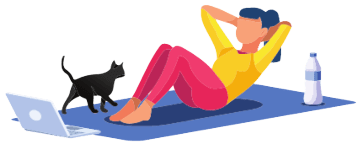Let’s Talk More About Bones, Part Two: Scoliosis
In a recent column, I wrote about osteoporosis and how this bone disorder can affect quality of life, posture, and ease of movement. I shared lots of information about how there are indeed ways to alter the trajectory of osteoporosis through well-designed exercises, balance training, and attention to nutrition and habits.
For more information about osteoporosis, please feel free to reach out to me at my email address: lisa@athomebefit.com

In this column, we’ll consider another bone-related disorder, scoliosis, and how it too can impair function and well-being. Scoliosis is a curvature of the spine, and it creates areas of tension or shortness throughout the body while leaving other areas over-lengthened. In other words, the myofascial tissues within the entire body have imbalances in relation to the bones. This imbalance can lead to pain, postural changes, and over time, possibly a change in the shape of the bones.
Scoliosis is often diagnosed in young people, and more often in girls. There are many types of scoliosis, but for the purpose of this article I’m going to focus on DLS, Degenerative/Adult Lumbar Scoliosis. This form of scoliosis occurs in over 35% of older adults, some beginning around the age of 50, and the percentage of those affected rises with increasing age.
Without delving into the specifics of diagnosing scoliosis, there are current therapy methods that may be helpful, many based on the exercises created by Katharina Schroth beginning in the 1920s, and later in her clinic. These exercises are now widely known as the Schroth Method. Today, practitioners use Schroth exercises to assist with unwinding the curves of scoliosis and restoring the tensegral relationships of the bones and the soft tissue.

Think about the curves in scoliosis and where they occur—they’re sideways or lateral curves, or curves that are in the frontal plane. Consider, too, that soft tissues are often involved in maintaining the position of the skeletal geometry. Before starting on a journey of adding exercises for improving scoliosis, assessing current posture is necessary, and current X-rays can help greatly, giving the trainer or therapist a view into the current placement of the bones in the torso. Also, Body Reading, a technique created by Tom Myers during his development of Anatomy Trains work, may assist with creating exercises. Body Reading is performed by a skilled practitioner trained to notice why the bones and soft tissue are in a curving pattern, allowing for the development of an integration story during treatment.
After the assessment, special tools and specific, well-intentioned exercises are developed for the curves. Both short and long-term strategies can then be used to create a difference in the body. With frequent exercise practice, someone with scoliosis patterns may begin to unwind the spine and restore tensegral relationships in the body. The exercises are often taught in a series of 4-6 sessions and use expansion breath-work, traction, passive corrections with small pads and wedges, and both standing and all-fours core training. Many of these exercises can be incorporated into a home-based routine.
It’s important to note that scoliosis can’t be cured. However, the frequent use of the exercises can create a greater awareness of the body’s form and posture, and if someone is experiencing pain from scoliosis, the exercises may offer some relief.
If you have noticed a change in your posture or if you have scoliosis, consider seeking out the assistance from a practitioner trained to offer exercises using the Schroth Method, or someone trained in other forms of myofascial work.
